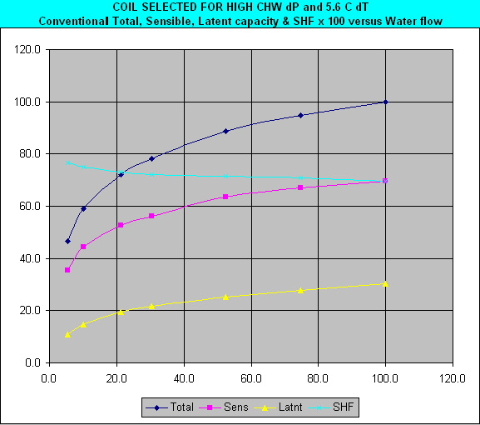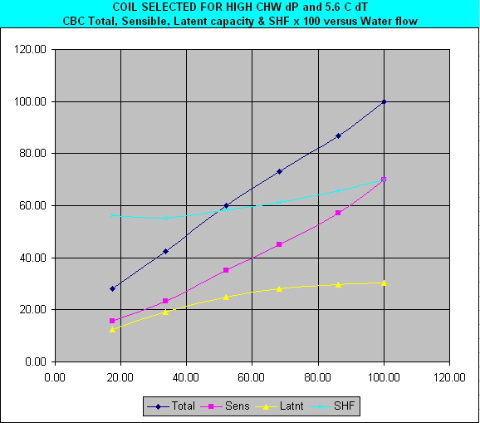

High ΔP Coil Test Results |
Page 1. HIGH ΔP, LOW ΔT CHW COOLING COIL TEST Although described as High ΔP, Low ΔT, chilled water cooling coil, the reference is to “traditional” selection where the coil chilled water circuit flow velocity is selected High, resulting in High dP and the chilled water temperature rise is selected at the traditional 10 deg F, ~ 5.6 deg K, thus Low dT. Page 2. Conventional and CBC controlled coil performance compared versus Chilled Water Flow. Page 3. Conventional and CBC controlled coil performance compared versus Sensible Cooling Capacity. Page 4. Sensible Capacity compared versus Chilled Water Flow, and Space RH% also Condensate Removal ability versus Sensible Capacity. Page 5. Conventional and CBC controlled coil Chilled Water Pump kW versus Total Cooling Capacity. Page 6. Comparison of Conventional and CBC CHW Pump kW versus Total Cooling Capacity. Executive summary: A: CBC exhibits outstanding Partial Load performance in
regard of maintaining Space Relative Humidity and Controllability. |
| Page 2. Traditional display of chilled water cooling coil performance against water flow (X Axis) illustrated below. The coil selection is at high full load circuit flow velocity to enable the Conventional Coil to function at part load. From left to right; Conventional Coil and CBC Coil. |
| The Conventional Coil displays the well published partial load characteristics with increasing Sensible Heat Factor (SHF) towards low load, while the CBC Coil shows near linear Total Capacity versus Water Flow Rate and a decreasing Sensible Heat Factor towards low load levels |
| Page 3. Results plotted against Sensible Capacity (X Axis), to illustrate Partial Load Coil Performance versus Sensible Capacity, and aptly so, since stand alone cooling coils without some form of reheat or air bypass are controlled only from space dry bulb temperature deviation from set point. Conventional and CBC controlled coils illustrated below from left to right. |
| Despite the high circuit flow velocity, high CHW pressure drop selection, it is near impossible to unload the Conventional Coil below 50% Sensible Capacity. This particular CBC Coil unloads close to 20% Sensible Capacity (Limited only by the 6 circuits of coil tested) and exhibits far superior partial load dehumidification of conditioned space without reheat. |
| Page 4. Sensible Capacity versus Water Flow (X Axis), also Space RH% and Condensate Quantity versus Sensible Capacity (X Axis), from left to right respectively. |
| Controllability of Conventional Coil below 50% Sensible Capacity is a problem, as this particular coil at ~8% Water Flow is still at ~50% Capacity, while CBC shows near linear Capacity response to Water Flow. Space RH% of Conventional reaches ~70% at ~75% Sensible Load, while CBC shows ~70% at ~45% Sensible Load. Condensate removal graphs clearly illustrate the reason for the foregoing. Note: Condensate is collected for 10 minutes after test conditions are stabilised. |
| Page 5. Plotted against Total Capacity (X Axis), to illustrate part load CHW Pump kW, which is proportional to Chilled Water ΔP x Volume. For comparison the Conventional Pump kW is taken as 100% at Full Total Load. The high System ΔP requirement of Conventional Coil is due to the control valve ΔP, which is often 1.5 times of the Coil ΔP to maintain controllability. Conventional and CBC, left to right respectively. |
| Note: High ΔP control valve is not required for CBC Controls, in fact the New Generation CBC incorporates the control valve, thus an external control valve becomes obsolete. For clarity direct comparison of Pump kW requirements is shown on the following page. |
| Page 6. Comparison of High Pressure Drop Conventionally Controlled and CBC Controlled CHW Cooling Coils, in respect of CHW Pump kW partial load requirements, versus Total Capacity (X Axis). Evidently, equipping this particular coil with CBC Controls, CBC Pump kW reduction is only available above ~78% Total Capacity, below this CBC will in fact use more Pump kW than the Conventional |
| Conclusion: The foregoing clearly shows the Partial Load Psychrometric and Controllability advantage of CBC, however for CBC to exhibit across the load range energy savings, the coil needs to be selected at Low CHW Circuit Flow Velocity, thus Low ΔP and High CHW Temperature Rise. |